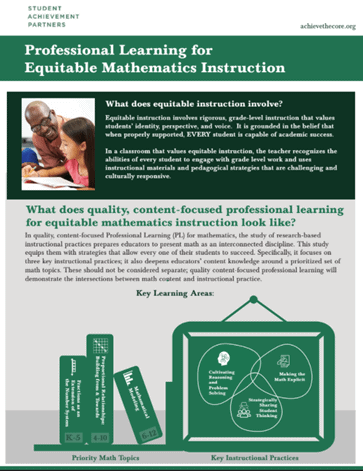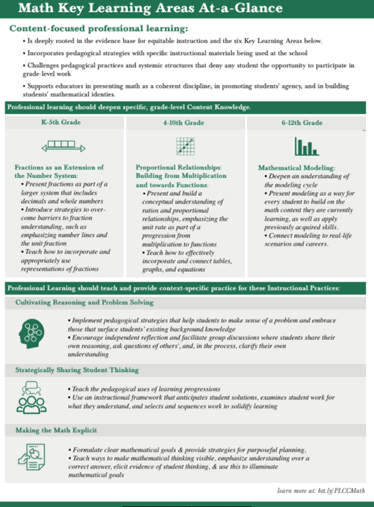In a previous post, we described how the Professional Learning (PL) Core Content is derived from the Principles for High-Quality, Standards-Aligned Professional Learning. To continue this series, this post will introduce the Key Learning Areas for mathematics professional learning. (For information about the ELA/literacy Key Learning Areas, see this post.)
What is the content that should be at the focus of math professional learning?
Math professional learning should support teachers in creating equitable math classrooms. We believe equitable classrooms are founded in the belief that every student can engage in rigorous, grade-level work that values their identities, perspectives, and voices. Professional learning that develops deep content knowledge and pedagogical expertise can support teachers in providing equitable instruction for each and every student. The PL Core Content Key Learning Areas in math, pictured below, outline the focus of this knowledge and expertise.
Why these Key Learning Areas?
Content-focused professional learning in mathematics lives at the intersection of content knowledge and instructional practice. The three instructional practices represent the elements central to an equitable mathematics classroom. They present math as a coherent discipline and math problems as opportunities to learn mathematics, while also positioning students as owners of mathematical knowledge. However, professional learning on any of these instructional practices needs to be grounded in a deep study of math content. The three selected math topics represent content for which college- and career-ready standards likely look different than how many teachers may have learned this content in their own K-12 experience. Instructional materials have also historically demonstrated less alignment to college- and career-ready standards, and to learning progressions, in respect to these topics. Therefore, they represent high-leverage math topics to study. Starting with these math topics as the focal content knowledge for professional learning will not only be immediately relevant for teachers’ instruction, but will also likely build teachers’ skill in patterns of inquiry that will help them grow their expertise in other math topics.
How have some PL practitioners used this guidance?
We surveyed PL designers, who informed the content of this guidance, on how they have applied the guidance to the professional learning they are designing. Here are a few responses from these practitioners:
What resources can I explore to get started with designing?
Explore the Key Learning Areas:
- Watch this video that introduces the PL Core Content for Mathematics.
- Check out the Prezi below to explore the structure of the Mathematics Key Learning Areas and navigate to your particular areas of interest.
- Review the broadsheet pictured below and linked here. It frames professional learning for equitable mathematics instruction and provides quick details on the Key Learning Areas.
 |
 |
- Read more about the PL Core Content Key Learning Areas for mathematics in the full resource here.



















